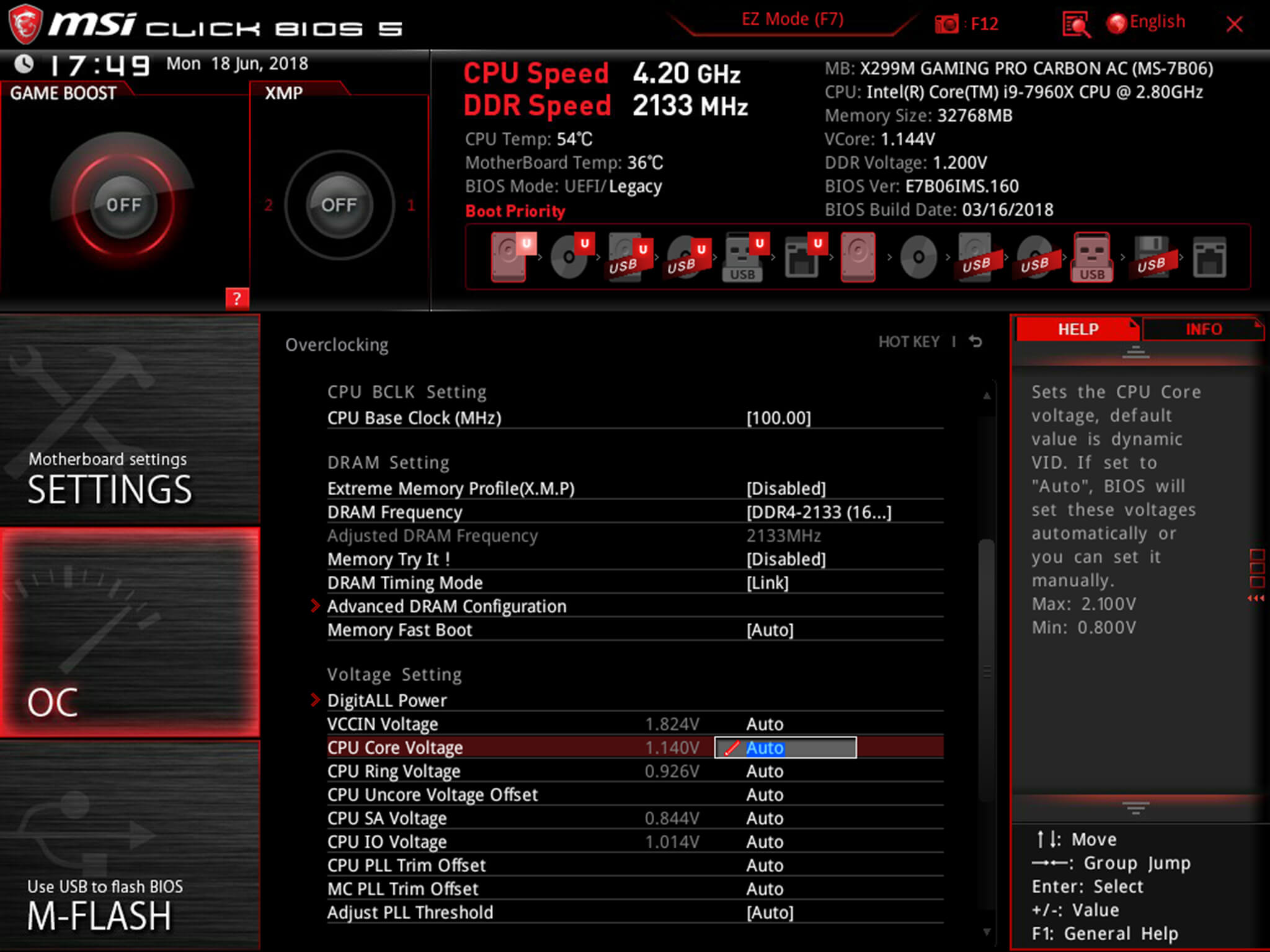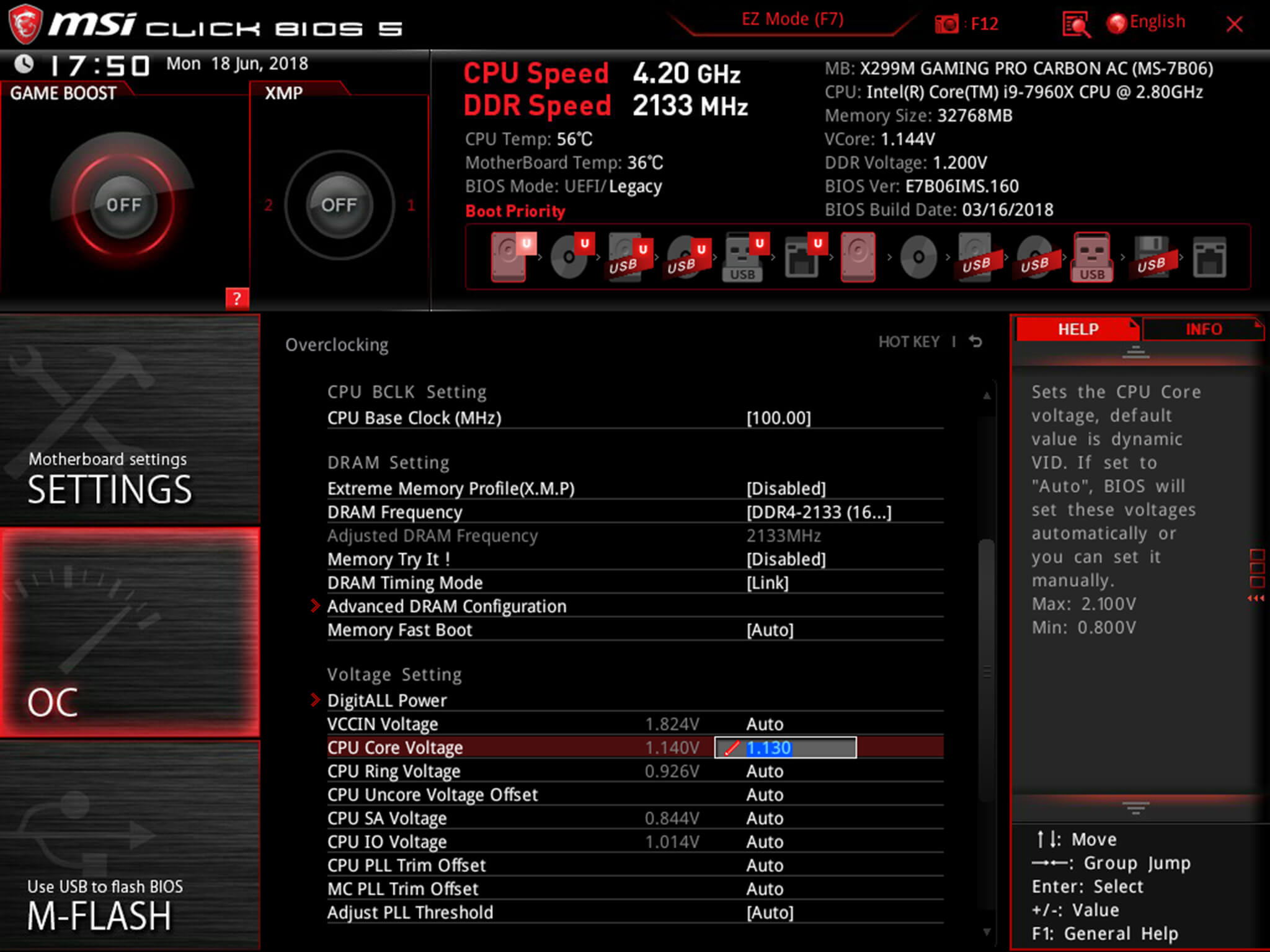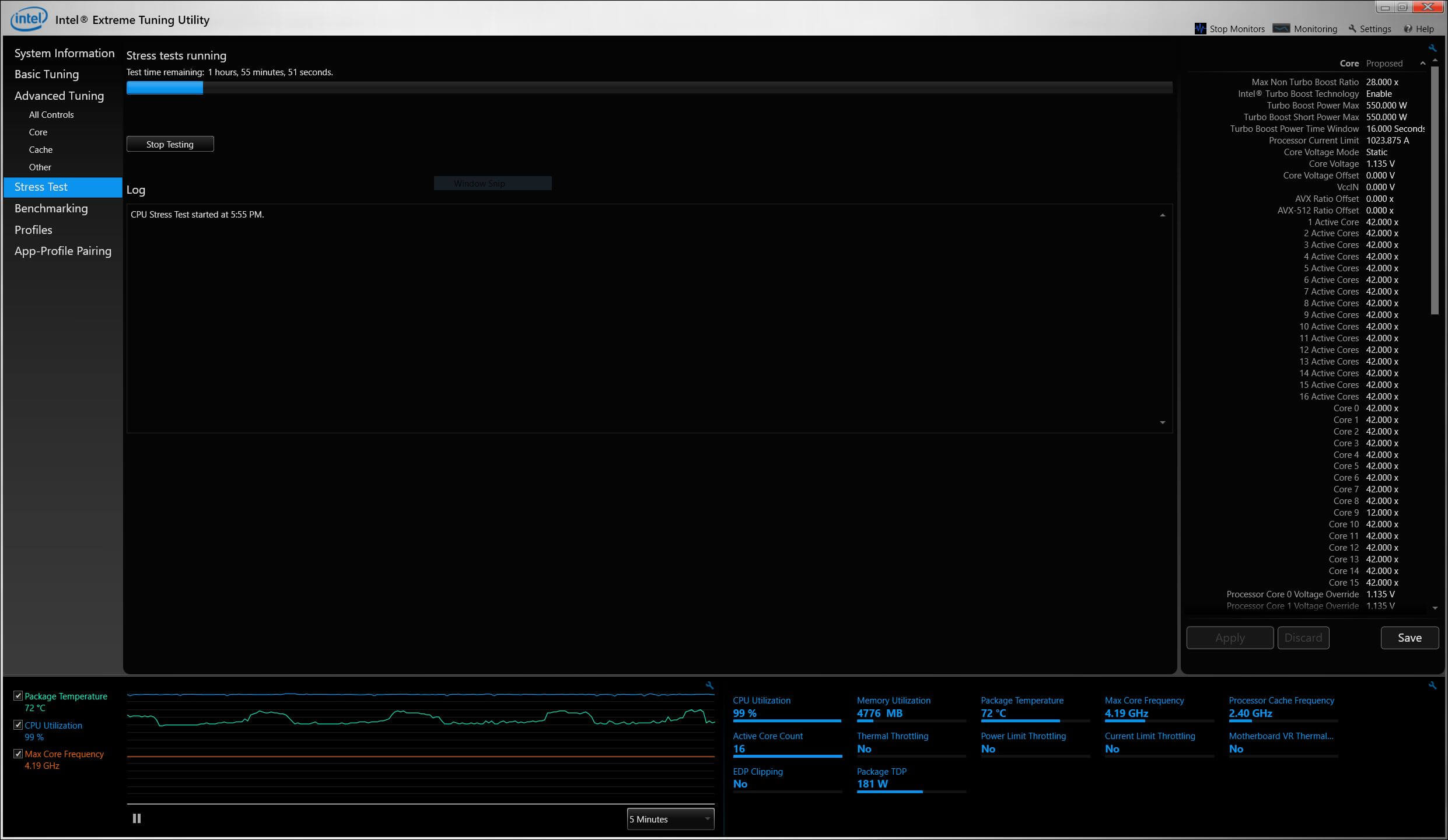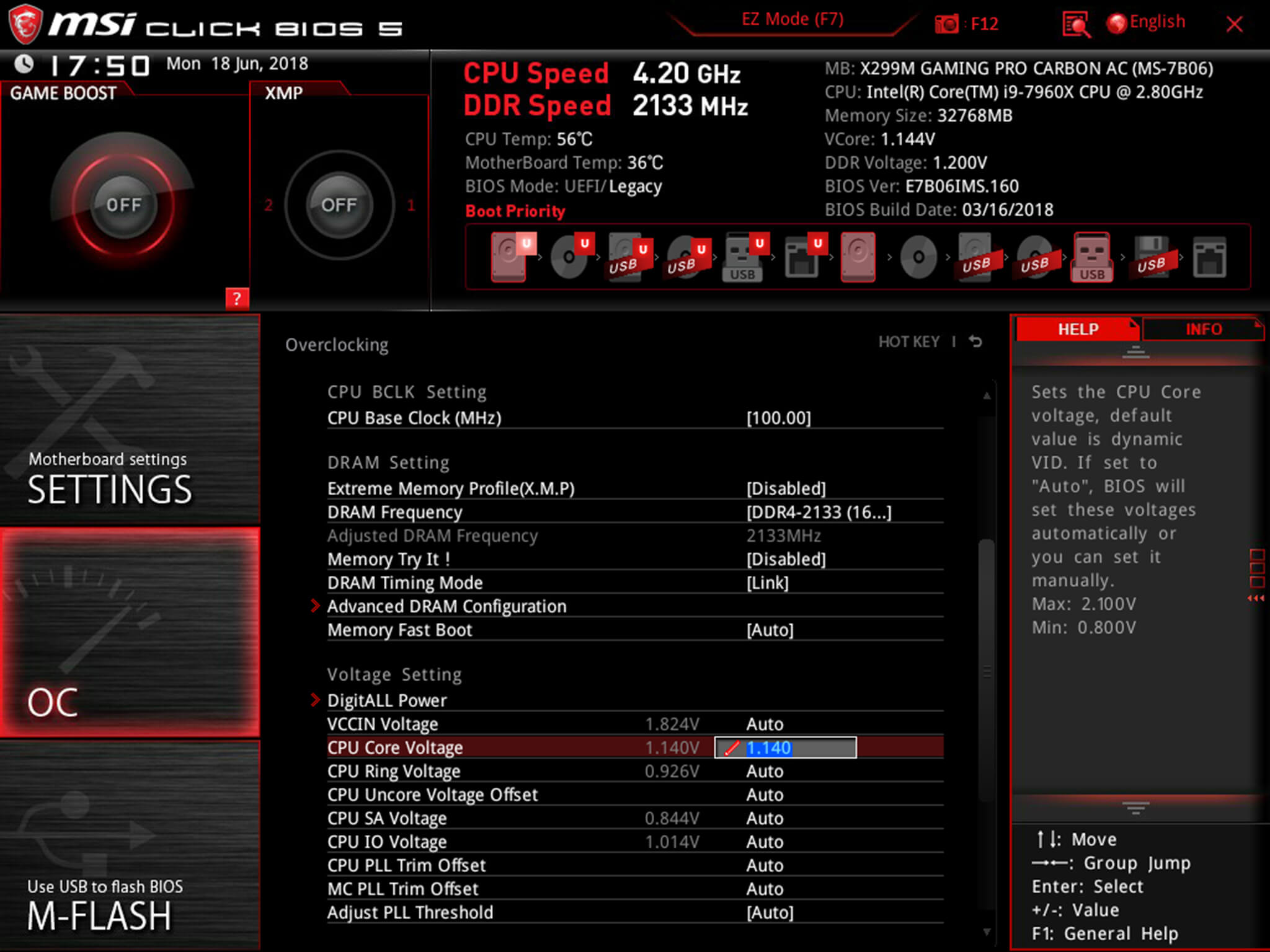The core voltage is different for each processor model, and while all CPUs of the same model have the same VID, not all samples maintain stability at the same clock speeds and Vcore due to slight variations in silicon quality. Every sample of the same CPU model is tested to maintain stability at the default speeds and the VID determined by the manufacturer.
Core voltage typically maintains a constant value while your CPU is in use; however, sometimes under heavy workloads vcore can fluctuate. This is known as Vdroop and can be corrected with load-line calibration. This applies additional voltage as load increases to maintain your CPU's stability.
When it comes to overclocking, you can only push your CPU's frequency so far before your CPU starts to experience instability. Programs might begin to crash or hang up, game performance could suffer or your computer could even fail to boot. This is because your processor isn't getting enough voltage to maintain system stability.
Increasing voltage will allow you to dial in the perfect overclock.
To adjust the voltage, you'll need to boot into your motherboard's BIOS and make adjustments there. The Vcore is expressed as a three decimal value, such as 1.235v. By default, the voltage control is set to auto; this can be overridden by typing in any value. Make sure not to exceed the recommended maximum for your processor.

Before fine-tuning the Vcore, it's important to find a good baseline value for a given speed. This varies from model to model but it can be helpful to read reviews for your CPU, specifically ones that focus on overclocking.
Most publications will list the voltage they required to keep several different speeds stable. Every CPU sample is different and you will need to fine-tune the voltage before calling it done; however, these values do provide a good starting point.

If you boot your machine and don't find any stability issues, then you know it's time to start decreasing the voltage. When overclocking, you want to find the lowest voltage required to maintain stability. More voltage equals more heat and this will allow you to keep temperatures under control.

The safest way to adjust voltage is with increments of .01 volts. Decrease voltage until your computer starts showing signs of instability under load. Use a program like Intel's Extreme Tuning Utility (XTU) or Prime95 to stress test your processor.
If the test fails or crashes, then you need to raise the voltage back up to the previous stable point. For optimal efficiency, you can increase the voltage by .005 instead and again test for stability.

Conversely, if your overclock isn't stable at your baseline voltage, you will then need to increase the voltage until your computer shows no adverse effects and then decrease in increments of .005 to fine tune.

Overclocking is not the only time it can be useful to adjust voltage. As mentioned, higher voltage levels cause your CPU to generate more heat, regardless of frequency. Some CPU samples may have a higher VID than is actually required at the default frequency. Undervolting your processor allows your to maintain stability while decreasing temperatures and extending the life of your processor.
It's a common misconception that disabling Turbo Boost is a more effective substitute for shedding heat. While this does result in decreased temperatures, it is not an alternative as the purpose of undervolting is to maintain the same level of performance while generating less heat. When making adjustments, the same principles apply here as with overclocking, decrease Vcore in increments of .01 and then fine tune with adjustments of .005.
 Wombat butt biting sex habits could be helpful for its survival
Wombat butt biting sex habits could be helpful for its survival
 Tennessee vs. UCLA 2025 livestream: How to watch March Madness for free
Tennessee vs. UCLA 2025 livestream: How to watch March Madness for free
 Scientists find supercolony of penguins on the remote Danger Islands
Scientists find supercolony of penguins on the remote Danger Islands
 Amazon Spring Sale 2025: Best Apple AirPods 4 with ANC deal
Amazon Spring Sale 2025: Best Apple AirPods 4 with ANC deal
 The Beatles biopic casts all the internet's boyfriends in one movie
The Beatles biopic casts all the internet's boyfriends in one movie
 Best Bluetooth tracker deal: Save 29% on the Tile by Life360 Essentials bundle
Best Bluetooth tracker deal: Save 29% on the Tile by Life360 Essentials bundle
 Here are the glorious proposed logos for Donald Trump's Space Force
Here are the glorious proposed logos for Donald Trump's Space Force
 Elon Musk says Mars ship could make first flights in 2019
Elon Musk says Mars ship could make first flights in 2019
 Elon Musk makes request to Reddit CEO to take down posts he didn't like
Elon Musk makes request to Reddit CEO to take down posts he didn't like
 Best travel deal: Score the Frontier Go Wild! summer pass for just $399
Best travel deal: Score the Frontier Go Wild! summer pass for just $399
 Best JBL deal: Save $10 on the Go 4 at Amazon
Best JBL deal: Save $10 on the Go 4 at Amazon
 Switch 2 Nintendo Direct: Everything announced
Switch 2 Nintendo Direct: Everything announced
 Sony PULSE Elite PS5 headset open
Sony PULSE Elite PS5 headset open
 New Zealand will ban plastic bags for good
New Zealand will ban plastic bags for good
 UGREEN Nexode 25000mAh 200W power bank drops to $79.99 at Amazon
UGREEN Nexode 25000mAh 200W power bank drops to $79.99 at Amazon
 Best smartwatch deal: Save 44% on CMF Watch Pro for $38.90 at Amazon
Best smartwatch deal: Save 44% on CMF Watch Pro for $38.90 at Amazon
 Here are the glorious proposed logos for Donald Trump's Space Force
Here are the glorious proposed logos for Donald Trump's Space Force
Banksy claims responsibility for new Brexit mural in England'SNL' cuts the sexual tension on 'Morning Joe' with an awkward knifeCan Uber become a 'just' workplace? CEO Travis Kalanick lays out the planFinal 'Wonder Woman' trailer: More action, more weapons, and Dr. PoisonNick Viall has his own men's grooming startup, of courseUniversity sparks Twitter war after listing a 'Trumpism & U.S. Democracy' classNASA needs your help to speed up its supercomputer codeThis 'teacup pig' shocked her owner by growing into a 150kg pig in 8 monthsNASA just schooled actor Milo Ventimiglia about space because TwitterCool kid who read 1 million words is a living, breathing sunglasses emojiWas Fyre Festival a Ponzi scheme? Lawsuit says organizers knew it was fraudAdele celebrates her 29th birthday with a delightful 'old lady' photoshootEmma Watson's wins first genderTiny, adorable baby animal rescued from imminent doom by hero ArizonansNicki Minaj gives straightGuy masterfully photobombs bachelorette party on the streetGoldie Hawn and Kurt Russell had a delightful time on the Walk of FameCelebrities and normals alike sport their fanciest hats at the Kentucky DerbyNicki Minaj gives straightThis website wants to help you mail your ashes to Republican congressmen Futurists predict what your sex life may look like after the pandemic Elon Musk: My dog is running Twitter now What is a spit kink? Here's everything you need to know. Why Spotify is killing Wordle 'Quordle' today: See each 'Quordle' answer and hints for April 14 National parks will be bizarre this summer 'Wordle' today: Here's the answer, hints for April 14 'Barry' Season 4 review: A ruthless end to a brilliant show Twitter Blue now allows tweets up to 10,000 characters long The internet got a glimpse of Dr. Fauci's home office and they want more 'Yellowjackets' Season 2, episode 4: Misty and Walter are an oddball ship for the ages Trump says he's taking controversial COVID This social distancing picnic blanket will make you look forward to summer Martin Shkreli won't get released from prison to research coronavirus Here are the 15 best tweets of the week 'Wordle' today: Here's the answer, hints for April 12 'Beef' is full of '90s and '00s gems. Why does the soundtrack work so well? 10 ways to make your work from home desk less depressing Elon Musk just shut down automation for important public safety accounts Hulu's 'Am I Being Unreasonable?' review: A quirky British series you need to watch
1.6631s , 10133.4609375 kb
Copyright © 2025 Powered by 【To Be Twenty (Avere vent’anni)】,Co-creation Information Network